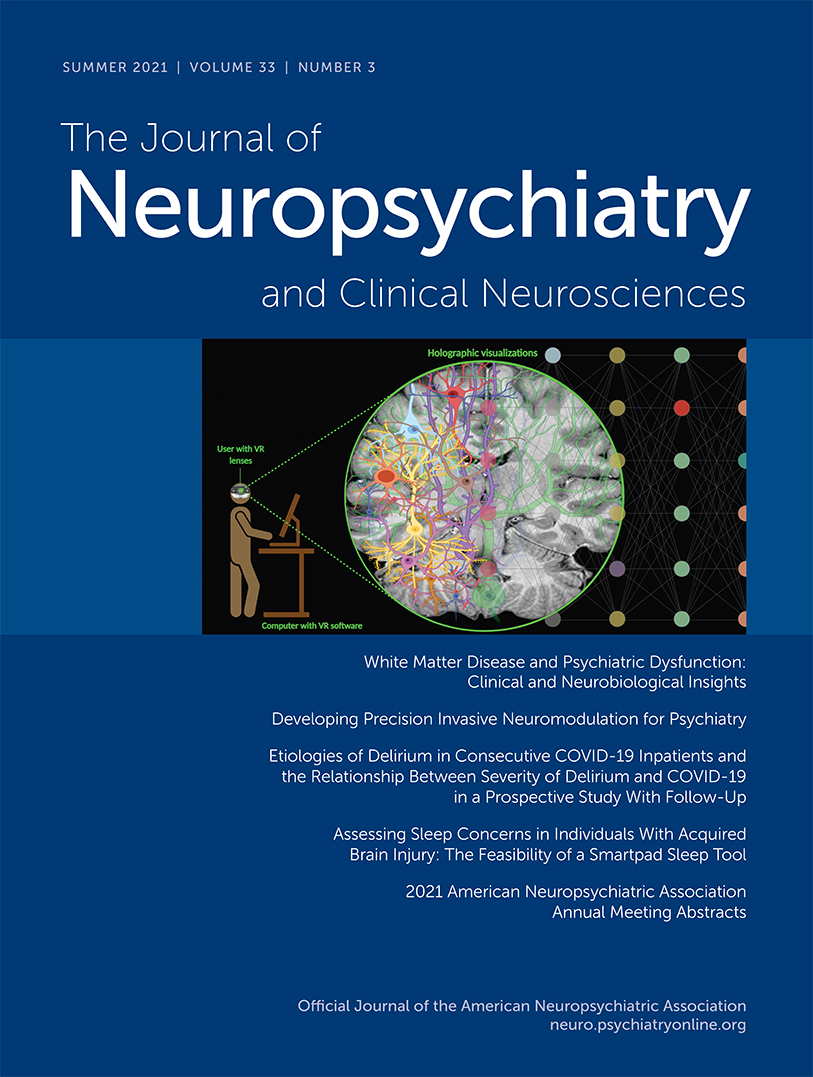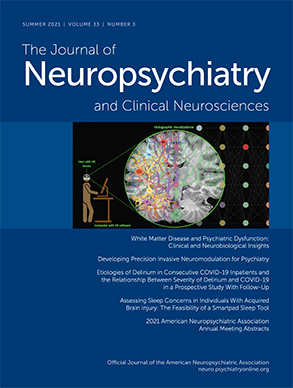One of the most important tasks facing physicians and other health care providers is the making of an accurate diagnosis. In no discipline is this task more critical than in psychiatry, a specialty focused on the evaluation and treatment of conditions with especially challenging differential diagnostic considerations. This challenge is frequently compounded by the possibility that neurologic disease may be masquerading as a presumed psychiatric disorder. Clinicians evaluating such patients are no doubt familiar with the experience of questioning whether a patient’s presentation may in fact indicate a brain disease when schizophrenia or bipolar disorder seems more likely at first glance. Perhaps the best known—and arguably most worrisome—example of this situation is the discovery of a brain tumor producing psychiatric phenomenology with no other evidence of neurologic dysfunction (
1).
The widespread availability of MRI in developed countries has allayed much concern about missing occult brain diseases, and failure to diagnose structural lesions is fortunately becoming less common. Yet MRI is not practicable in every case of psychiatric disturbance, and guidance is needed in how to apply this very sensitive technique to gain maximal diagnostic benefit. The review by Costei and colleagues (
2) offers a useful guide to help organize thinking about this topic, focusing specifically on the uncommon but fascinating hereditary white matter diseases that can be difficult to recognize.
Hereditary leukoencephalopathies typically present in infancy and childhood with dramatic neurologic dysfunction and rapid progression, but they can also occur in adolescence or adulthood with a more insidious onset. Psychiatric dysfunction is a common presentation of several late-onset leukodystrophies, for example, and may precede neurologic features by many years. A familiar case in point is metachromatic leukodystrophy (MLD), a central and peripheral dysmyelinative disease caused by a deficiency of the enzyme arylsulfatase A (
3). Psychosis is a common feature of late-onset MLD, reported as present in 53% of adolescent and early adult-onset cases, and disrupted corticocortical and corticosubcortical connections, especially involving the frontal lobes, have been theorized as critical (
4). Late-onset MLD has even been hypothesized as a naturally occurring model of schizophrenia (
5). A variety of other hereditary white matter diseases may also present psychiatrically, and given the importance of accurate diagnosis to facilitate appropriate and timely treatment, consideration of these disorders is relevant for psychiatric clinicians.
From their review of the literature, Costei and colleagues found several clues to the diagnosis of a hereditary leukoencephalopathy that should prompt MRI scanning in patients with psychiatric symptoms and signs. These include the presence of drug-resistant symptoms, neurological and systemic features not expected with typical psychiatric disease, trigger events (such as traumatic brain injury, infection, and emotional distress), consanguinity, and a positive family history. The authors also provide an MRI algorithm for identifying hereditary white matter disorders in adults who present psychiatrically. This information will prove helpful for clinicians faced with the question of how to go about the evaluation of patients whose psychiatric presentations may be atypical.
In highlighting the association of genetic white matter disease with psychiatric disturbance, this work also raises the intriguing question of whether white matter dysfunction may be implicated in typical psychiatric disease. Since the advent of the MRI era that enabled regular identification of white matter disorders, a steady stream of reports and reviews has appeared on the hypothesis that disrupted white matter connectivity may underlie a wide range of psychiatric disorders that have otherwise defied neurobiological understanding, including schizophrenia, depression, bipolar disorder, autism, and posttraumatic stress disorder (
4–
10). The appeal of this idea is that it may lead to an explanation of psychiatric illness that arises from distributed neural network dysfunction rather than focal cerebral lesions, distinct neuropathologjcal changes, or neurochemical alterations, but it remains conceptually difficult to explain the diverse panoply of psychiatric phenomenology by a simple nod to disconnectivity. Connectivity surely matters, but how does its breakdown produce psychiatric disturbance? Still, the notion that altered white matter connectivity leads to disturbed timing of impulse transmission and asynchronous cortical activity, and hence functional disruption of networks subserving emotional regulation (
6–
8), merits neurobiological attention.
In contrast to the readily observable neuropathology of hereditary white matter diseases, psychiatric diseases have been hypothesized to arise from more subtle changes in white matter, and substantial work in recent years has focused on glial cells. First and most obvious are oligodendrocytes, the central nervous system (CNS) glia responsible for myelinating axons (
8,
9). Multiple genes influencing oligodendrocyte function have been implicated in the pathogenesis of schizophrenia, for example, and the subsequent dysfunction of these cells plausibly leads to the degraded integrity of multiple white matter tracts in affected patients (
8,
9). More recently, as interest in inflammation as a mediator of many neuropsychiatric disorders has rapidly evolved, microglia have also been implicated in primary psychiatric diseases (
10). Microglia, the resident immune cells of the CNS, are substantially more abundant in white matter than gray matter (
11), and in schizophrenia, evidence exists to suggest that activated microglia contribute to oligodendrocyte dysfunction, hypomyelination, disrupted white matter integrity, and cerebral dysconnectivity (
10).
To summarize, the review by Costei and colleagues adds to a steadily growing body of knowledge regarding the role of white matter in psychiatric illness. Their work has clear diagnostic implications for clinicians evaluating patients who present with psychiatric features. More broadly, the data from this and many other studies indicate that psychiatric disorders may arise de novo from disruption of myelinated tracts in the brain (
4–
10). This disruption may result from acquired damage to myelin and axons, and in parallel, evidence is expanding that implicates genetic abnormalities in glial cells required for normal myelination and network function. Given the lingering uncertainties in understanding the structural basis of psychiatric diseases, the possibility that acquired or genetic events affecting the brain white matter may lead to the clinical expression of psychiatric illness deserves further study. Adopting a leukocentric perspective may well result in additional insights disclosed by clinical and laboratory investigations of the myelinated tracts of the brain that are so often underappreciated.

